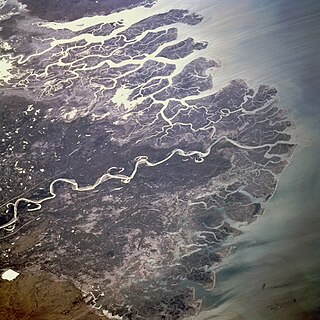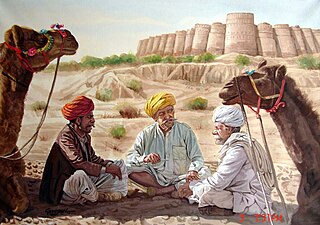This article needs additional citations for verification .(February 2024) |
The Jhabel are a Sindhi-speaking tribe, found in the province of Punjab, Pakistan. [1]
This article needs additional citations for verification .(February 2024) |
The Jhabel are a Sindhi-speaking tribe, found in the province of Punjab, Pakistan. [1]
The Jhabel are essentially a tribe of fishermen and boatmen, found in the southern districts of Punjab, mainly along the banks of the Indus and Sutlej rivers. In additions, they are also involved in collecting water-lilies, which prized as a herb. They say they are descended from Bhatti Rajputs, who fell into poverty, and took to fishing. According to other traditions, their ancestor is said to have come originally from Sindh, and they belonged to the Mallaah tribe. Other tribes like Kutana, Kihal and Mor are thought to have same origin. [1] Many members of the tribe have taken agriculture, particularly those found along the banks of the Sutlej. The Jhabel are Sunni Muslims, following both the Barelvi and Deobandi sub-sects. More than any other community, they have been affected by the damming of the Punjab rivers, which has led to the abandonment of their traditional occupation as boatmen. Many are landless, working as tenant farmers for the large land owners that dominate southern Punjab.

The Indus is a transboundary river of Asia and a trans-Himalayan river of South and Central Asia. The 3,180 km (1,980 mi) river rises in mountain springs northeast of Mount Kailash in Western Tibet, flows northwest through the disputed region of Kashmir, bends sharply to the left after the Nanga Parbat massif, and flows south-by-southwest through Pakistan, before emptying into the Arabian Sea near the port city of Karachi.

Sindh is a province of Pakistan. Located in the southeastern region of the country, Sindh is the third-largest province of Pakistan by land area and the second-largest province by population after Punjab. It is bordered by the Pakistani provinces of Balochistan to the west and north-west and Punjab to the north. It shares an International border with the Indian states of Gujarat and Rajasthan to the east; it is also bounded by the Arabian Sea to the south. Sindh's landscape consists mostly of alluvial plains flanking the Indus River, the Thar Desert of Sindh in the eastern portion of the province along the international border with India, and the Kirthar Mountains in the western portion of the province.
Sindhis are an Indo-Aryan ethnolinguistic group, originating from and native to Sindh region of Pakistan, who share a common Sindhi culture, history and language. The historical homeland of Sindhis is bordered by the southeastern part of Balochistan, the Bahawalpur region of Punjab and the Kutch region of Gujarat.

The Sutlej River is the longest of the five rivers that flow through the historic crossroads region of Punjab in northern India and Pakistan. The Sutlej River is also known as Satadru. It is the easternmost tributary of the Indus River. The Bhakra Dam is built around the river Sutlej to provide irrigation and other facilities to the states of Punjab, Rajasthan and Haryana.

Bahawalpur District is a district of Punjab, Pakistan, with capital the city of Bahawalpur. According to the 1998 Census it had a population of 2,433,091, of which 27.01% were urban. Bahawalpur district covers 24,830 km2. Approximately two-thirds of the district (16,000 km2) is covered by the Cholistan Desert, which extends into the Thar Desert of India. The district is a major producer of cotton.

The Indus River Delta forms where the Indus River flows into the Arabian Sea, mostly in the southern Sindh province of Pakistan with a small portion in the Kutch Region of India. The delta covers an area of about 41,440 km2 (16,000 sq mi), and is approximately 210 km (130 mi) across where it meets the sea. The active part of the delta is 6,000 km2 in area (2,300 sq mi). The climate is arid, the region only receives between 25 and 50 centimetres of rainfall in a normal year. The delta is home to the largest arid mangrove forests in the world, as well as many birds, fish and the Indus dolphin.
The Mallaah are the traditional boatmen and fishermen tribes or communities found in North India, East India, Northeastern India and Pakistan. A significant number of Mallaah are also found in Nepal and Bangladesh. In the Indian state of Bihar, the term Nishad includes the Mallaah and refers to communities whose traditional occupation centred on rivers. It is also spelled Mallah.
The Sikhs are adherents to Sikhism, the fifth largest organized religion in the world, with around 25 million adherents. Sikh History is around 500 years and in that time the Sikhs have developed unique expressions of art and culture which are influenced by their faith and synthesize traditions from many other cultures depending on the locality of the adherents of the religion. Sikhism is the only religion that originated in the Punjab region with all other religions coming from outside Punjab. All the Sikh gurus, many saints, and many of the martyrs in Sikh history were from Punjab and from the Punjabi people. Punjabi culture and Sikhism are mistakenly considered inseparably intertwined. "Sikh" properly refers to adherents of Sikhism as a religion, strictly not an ethnic group. However, because Sikhism has seldom sought converts, most Sikhs share strong ethno-religious ties, therefore it is a common stereotype that all Sikhs share the same ethnicity. Many countries, such as the U.K., therefore misconcievingly recognize Sikh as a designated ethnicity on their censuses. The American non-profit organization United Sikhs has fought to have Sikhs included on the U.S. census as well, arguing that Sikhs "self-identify as an 'ethnic minority'" and believe "that they are more than just a religion".
The Balochs of Sindh,, is a community of Sindhi-speaking Baloch tribes living throughout the Sindh province of Pakistan.
Ubauro is a town in Ghotki District in Northern Sindh province, Pakistan.
The Baloch diaspora refers to Baloch people, and their descendants, who have immigrated to places outside the Balochistan region of South-West Asia – a region stretching from southwestern Pakistan to southeastern Iran and southern Afghanistan. The Baloch diaspora is found throughout the Middle East, South Asia, Turkmenistan, East Africa, Europe, North America and in other parts of the world.

The Saraikis, are an Indo-Aryan ethnolinguistic group native to the central Pakistan. They are multi-ethnic in origin and speak the Saraiki language.
Chachar or Chacher is a Sindhi Sammat agricultural tribe. They are found in the Sindh and Punjab provinces of Pakistan. They are considered fierce fighters.
The Baluch is a Muslim community found in the state of Uttar Pradesh, India. They are descended from Baloch tribesmen who settled in this region of North India in the late Middle Ages. The community use the surname Khan, and are often known as Khan Baloch

The topography of Pakistan is divided into seven geographic areas: the northern highlands, the Indus River plain, the desert areas, the Pothohar Plateau, Balochistan Plateau, Salt Range, and the Sistan Basin. All the rivers of Pakistan, i.e. Sindh, Ravi River, Chenab River, Jhelum River, and Sutlej River, originate from the Himalayas mountain range. Some geographers designate Plateau as to the west of the imaginary southwest line; and the Indus Plain lies to the east of that line.
Tando Bago is a town and union council in Badin District, Sindh, Pakistan. The Tehsil (township) of Tando Bago had a population of 321,818 in 2008. The Sindh government operates approximately 589 schools in Tando Bago.
The Warya is a Rajput and Jat clan found predominantly in the Punjab and Sindh provinces of Pakistan and in the state of Gujarat in India.
The Leghari, Lighari or Laghari is a Baloch tribe. The Leghari tribe mainly resides in Pakistan. The Sardar of Laghari tribe is Jamal Laghari, son of the previous Sardar, Farooq Laghari. They mostly speak Saraiki or Balochi in Punjab and Sindhi-Balochi or Sindhi in Sindh. Two centuries ago the Leghari tribe conquered a large part of what is today Dera Ghazi Khan District and established themselves at Choti Zareen. One of the most influential people from Leghari tribe who contributed in literature Nabi Bakhsh Khan Baloch was a Sindhi research scholar, historian, sindhologist, educationist, linguist and writer. He was author of some 150 books, he contributed to many subjects and disciplines of knowledge which include history, education, folklore, archeology, anthropology, musicology, Islamic culture and civilisation. One of the most prominent political figures in Sindh is Javed Nayab Laghari (Ex-Special Assistant to Chief Minister Sindh & President of People's Youth Organisation Sindh)

The Sindhi Bhils/Bheels are an Sindhinised sub-group of the Bhil people who live in the Sindh, Punjab, and Balochistan provinces of Pakistan. They are one of major Tribe Community in the region, and are one of the Hindu groups in Pakistan who are known to not leave Sindh during the Partition of India.
The Sindhis of Balochistan are an indigenous Sindhi population living in Balochistan, Pakistan.
Similarly, the two tribes Jhabel and Kutana arrived in this area most probably from Sindh and still speak the Sindhi language...